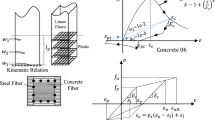Abstract
When a structure is subjected to an explosion, high blast pressure is initially released during a very short period of time and is followed by fire. The combined effects of blast and fire may cause damage and failure of one or more key elements of the structure leading to progressive collapse and failure of the entire structure. However, design procedures suggested by current standards and codes do not consider the combined effects of blast and fire because of the complexity of the problem, which involves inertia and heat effects with high geometrical and material nonlinearities. The ultimate aim of the present study is the numerical and analytical prediction of the behaviour and failure of steel columns subjected to blast pressure followed by fire. A new numerical model was developed and validated to perform both dynamic and transient thermal analyses simultaneously using the dynamic fully coupled thermal-displacement analysis procedure within ABAQUS/explicit. The proposed numerical model was validated against published experimental test results. The study also proposes a new simplified approach for analysing the combined effects of blast and fire on the response and critical temperature of steel columns. The suggested approach implements the single degree of freedom analysis method (SDOF) in conjunction with the resistance function of steel columns at elevated temperature. The proposed analytical method has been validated against published experimental results in addition to numerical simulation results conducted in this study, and the validation has shown very good correlation between the results. The validated analytical approach can be used in the preliminary analysis and design of steel columns under blast and fire.


































Similar content being viewed by others
References
AISC. (2005). Manual of steel construction. Load and resistance factor design (LRFD). 13th edition, Chicago, IL: American Institute of Steel Construction.
Al-Thairy, H. (2016). Modified single degree of freedom method for the analysis of building steel columns subjected to explosion induced blast load. International Journal of Impact Engineering, 94, 120–133.
Al-Thairy, H. (2018a). Behaviour and failure of steel columns subjected to blast loads: Numerical study and analytical approach. Advances in Materials Science and Engineering, 2018, 20.
Al-Thairy, H. (2018b). Analytical predictions of moment curvature relationship of steel beam columns under fire attack. MATEC Web of Conferences; BCEE3–2017:162 04006.
Al-Thairy, H. (2019). Residual strength of steel beam columns under elevated temperature. Constructional Steel Research, 155, 176–191.
Al-Thairy, H., & Wang, Y. C. (2013). A simplified analytical method for predicting the critical velocity of transverse rigid body impact on steel columns. International Journal of Impact Engineering, 58, 39–54.
ASCE. (1997). Design of blast resistant buildings in petrochemical facilities. Task Committee on Blast Resistant Design, ASCE.
Biggs, J. M. (1964). Introduction to structural dynamics. McGraw-Hill.
Chen, H. J., & Richard Liew, J. Y. (2005). Explosion and fire analysis of steel frames using mixed element approach. Journal of Engineering and Mechanics., 131, 606–616.
Ding, Y., Chen, Y., & Shi, Y. (2016). Progressive collapse analysis of a steel frame subjected to confined explosion and post-explosion fire. Advances in Structural Engineering, 19, 1–17.
Ding, Y., Wang, M., Li, Z. X., & Hao, H. (2013). Damage evaluation of the steel tubular column subjected to explosion and post-explosion fire condition. Engineering Structures, 55, 44–55.
Eurocode 3. (2005). Design of steel structures—Part 1–2: General rules—structural fire design. EN 1993–1–2:2005. European Committee for Standardization.
Forni, D., Chiaia, B., & Cadoni, E. (2017). Blast effects on steel columns under fire conditions. Journal of Constructional Steel Research, 136, 1–10.
International Organization for Standardization (ISO 834-1). (1999). Fire-resistance tests: Elements of building construction—Part 1: General requirements. Geneva
Izzuddin, B. A., Song, L., Elnashai, A. S., & Dowling, P. J. (2000). An integrated adaptive environment for fire and explosion analysis of steel frames—Part II: Verification and application. Journal of Constructional Steel Research, 53, 87–111.
Kim, J., Kang, S., & Choi, H. (2014). Failure temperatures of steel H-section columns under elevated temperatures. International Journal of Steel Structures, 4, 821–829.
Nassr, A., Razaqpur, A., Tait, M., Campidelli, M., & Foo, S. (2013). Dynamic response of steel columns subjected to blast loading. Journal of Structural Engineering (ASCE), 140, 04014036.
Quiel S.E., & Marjanishvili S.M. (2013). Response of steel columns to fire following blast. In: Proceedings of the 15th International Symposium on the Interaction of the Effects of Munitions with Structures (ISIEMS 15), Potsdam, Germany, pp 17–20.
Richard Liew, J. Y. (2008). Survivability of steel frame structures subject to blast and fire. Journal of Constructional Steel Research, 64, 854–866.
Richard Liew, J. Y., & Chen, H. (2004). Explosion and fire analysis of steel frames using fiber element approach. Journal of Structural Engineering, 130, 991–1000.
Simulia. (2014). Analysis user's manual, 6.14 ed. Providence, Rhode Island: Simulia, Dassault Systèmes.
Song, L., Izzuddin, B. A., Elnashai, A. S., & Dowling, P. J. (2000). An integrated adaptive environment for fire and explosion analysis of steel frames—Part I: Analytical models. Journal of Constructional Steel Research, 53, 63–85.
Srinivasan, C. (2019). Advanced steel design of structures. CRC Press.
USDOD. (2008). Structures to resist the effects of accidental explosions. Washington, DC: US Department of Defense (USDOD), p. 1507–10 [Chapter five]. Document No. UFC 3–340–02
Xi, F. (2016). Large deflection response of restrained steel beams under fire and explosion loads. Xi SpringerPlus, 5, 752.
Acknowledgements
The author of the manuscript would like to express his Acknowledgement to the services provided by the English editor Ms Claire Lynas for correcting the grammar and language errors in the entire manuscript.
Author information
Authors and Affiliations
Corresponding author
Additional information
Publisher's Note
Springer Nature remains neutral with regard to jurisdictional claims in published maps and institutional affiliations.
Rights and permissions
About this article
Cite this article
Al-Thairy, H. Prediction of Behaviour and Failure of Steel Columns Subjected to Blast Followed by Fire Induced by Explosion. Int J Steel Struct 21, 1431–1453 (2021). https://doi.org/10.1007/s13296-021-00514-w
Received:
Accepted:
Published:
Issue Date:
DOI: https://doi.org/10.1007/s13296-021-00514-w




